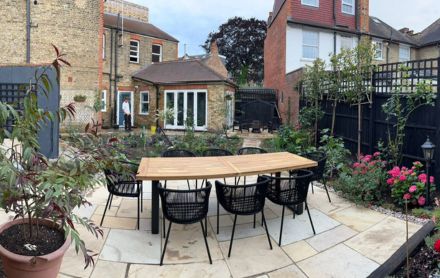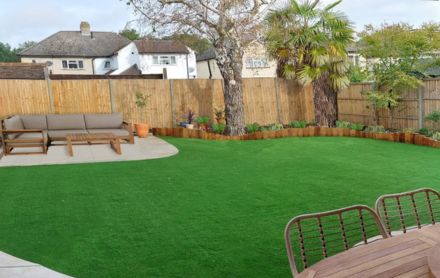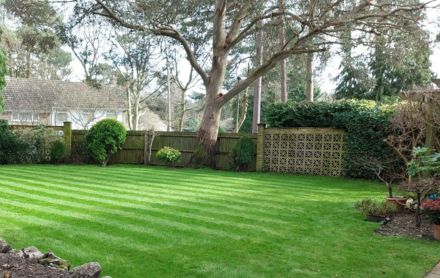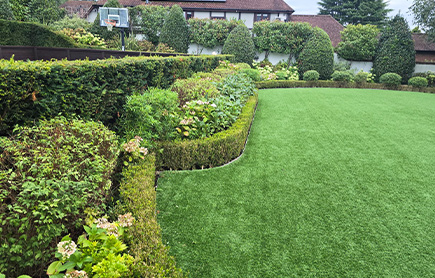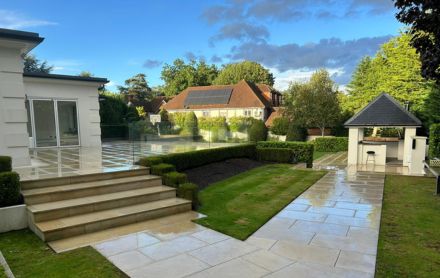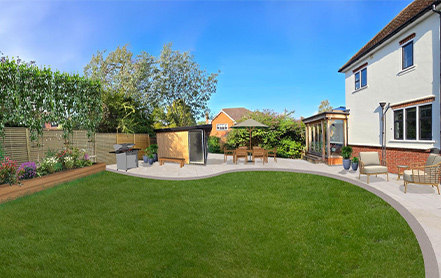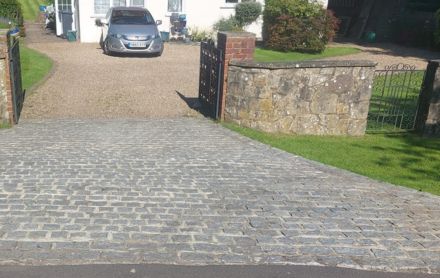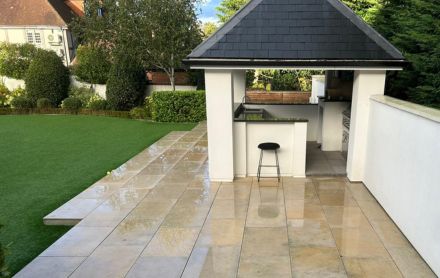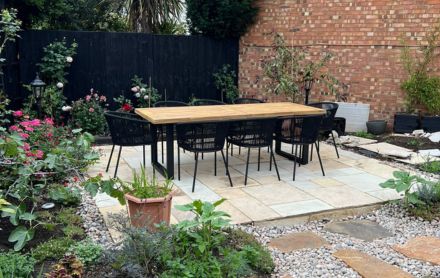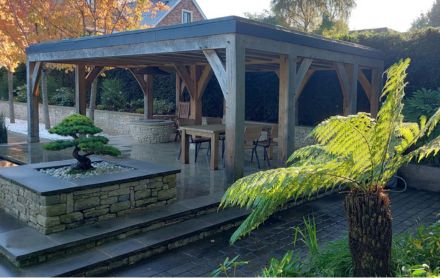Cottage Garden Design: A Comprehensive How-To Guide
A cottage garden is the stuff of daydreams. Imagine stepping outside into a space brimming with life, where fragrant roses climb over rustic arches and colourful flowers spill onto winding paths. This romantic, informal style, born in the English countryside, evokes a sense of nostalgia and effortless charm that feels both magical and deeply personal. For inspiration, explore a variety of gardens and outdoor spaces to spark creative ideas for your own design.
Cottage gardens are perfectly suited to UK homes, whether you have a sprawling lawn or a modest backyard. You can design a cottage garden for any type of house, including modern or new builds, not just traditional cottages. Their relaxed, abundant nature creates a sanctuary that feels worlds away from the everyday hustle.
If you’ve ever dreamed of creating your own floral haven but felt unsure where to start, this guide is for you. With professional insight from Beautiful Spaces, we’ll walk you through a step-by-step process to design a cottage garden that is as beautiful as it is achievable.
What Is a Cottage Garden?
Before diving into the design, it’s helpful to understand what truly defines this enchanting style. A cottage garden is more than just a collection of plants; it’s an artful blend of beauty and practicality, creating a space that feels both productive and picturesque.
The History and Charm of Cottage Gardens
The cottage garden style has its roots in the humble plots of English country villages from centuries ago. These gardens weren’t designed for aesthetics alone, as they were a vital source of sustenance. Villagers used their small plots of land to grow vegetables, herbs for medicinal and culinary use, and fruits.
Flowers were often tucked in wherever space allowed, attracting pollinators and adding splashes of colour. Berry-bearing plants and trees, such as Amelanchier, also attract birds by providing food and shelter, supporting local wildlife and enhancing biodiversity.
This emphasis on abundance, variety, and self-sufficiency created a distinct look: dense, layered, and seemingly untamed. It was a stark contrast to the formal, manicured gardens of the wealthy elite. The charm of the cottage garden lies in this joyful chaos—a celebration of nature’s beauty in its most generous form.
The Key Elements of a Cottage Garden
To capture the authentic cottage garden feel, you’ll want to incorporate several key elements. These components work together to create a space that feels harmonious, inviting, and full of character.
When considering cottage garden design, it’s important to blend aesthetics and functionality; planning your layout, plant choices, and materials to achieve both beauty and practicality.
- Informal Design: Forget rigid lines and perfect symmetry. Cottage gardens embrace a more organic layout. Think soft curves, meandering pathways, and plants that are allowed to self-seed and mingle.
- Layered Planting: Plants are packed closely together in varying heights, colours, and textures. This creates a lush, full look that draws the eye and makes the garden feel established and bountiful.
- A Mix of Plants: The classic cottage garden includes a diverse mix of flowering perennials, fragrant herbs, and even edible plants like leafy greens or berry bushes. Climbers, bulbs, and annuals are also essential for year-round interest.
- Natural Materials: Materials like weathered stone, rustic brick, and natural timber are used for paths, fences, and garden structures. These materials blend seamlessly with the planting and contribute to the garden’s timeless, rustic feel.
Step 1: Plan Your Layout
While cottage gardens appear spontaneous, a thoughtful layout is the foundation for success. A well-planned structure will guide you as you plant and ensure the garden flows beautifully, creating a relaxing and cohesive space. Start with a flexible garden plan that can be adapted as your project evolves, allowing you to visualise and adjust walkways, flower beds, and other areas as needed.
Start with Structure
Begin by defining the ‘bones’ of your garden. This includes boundaries, pathways, and distinct zones for planting or seating. Be sure to consider other areas, such as hidden corners or functional spaces that can add diversity and interest to your garden.
- Soft Boundaries: Instead of imposing walls, opt for softer boundaries that feel more integrated with the landscape. A classic picket fence, a low-growing hedge of lavender or boxwood, or a dry-stone wall can define the space while adding to its charm. When planning, also consider the placement of sheds to complement the overall design and provide practical storage.
- Winding Pathways: Create pathways that curve and meander through the garden rather than cutting straight across. This encourages a slower pace, inviting you to wander and discover different plants and views. Materials like gravel, reclaimed bricks, or flagstones enhance the rustic aesthetic.
Create Focal Points
Focal points are visual anchors that draw the eye and add interest to your garden layout. They can also help to create a sense of journey and purpose as you move through the space.
- Architectural Elements: A rose-covered arch or a rustic wooden arbour can serve as a beautiful entrance to a part of the garden. A charming birdbath not only looks lovely but also attracts wildlife.
- Seating Areas: Every garden needs a spot to sit and enjoy the view. Rustic, handcrafted benches nestled among the flowers or a small bistro set on a gravel patio can become a favourite retreat.
- Vintage Ornaments: An old watering can, a weathered terracotta pot, or a small stone sculpture can add a touch of personality and history.
Encourage a natural flow between these different spaces. The goal is to create an experience that feels relaxed and intuitive, where each part of the garden unfolds naturally. Treat the entire process as a rewarding garden design project that brings your vision to life.
Pathways and Walkways: Guiding the Journey
Pathways and walkways represent essential infrastructure elements within cottage garden design, enabling optimal navigation through abundant plantings whilst establishing opportunities for extended engagement and exploration. When developing your cottage garden strategy, it is crucial to utilise paths as comprehensive design solutions rather than mere transitional elements; they constitute significant opportunities to establish visual impact and enhance the overall user experience.
Utilising natural materials such as traditional brick, weathered stone, or textured gravel enables your garden pathways to achieve authentic, enduring aesthetic value. A strategically designed meandering pathway, incorporating gentle curves through established rose and lavender plantings, enhances visitor engagement by encouraging a deliberate pace and comprehensive sensory appreciation of garden elements.
These natural material selections not only establish seamless integration with existing plantings but also provide essential habitat infrastructure for bees and additional pollinating species, particularly when strategically aligned with aromatic plant varieties.
It is essential to incorporate designated seating installations along your pathway network, such as a strategically positioned wooden bench situated beneath climbing rose archways or bistro furniture arrangements integrated within bloom displays. These purposeful rest areas enable visitors to optimise their engagement with your garden environment.
For enhanced sensory benefits, incorporate lavender or additional aromatic herb varieties along pathway edges, ensuring each step activates fragrance release mechanisms.
Through systematic pathway and walkway design implementation, you establish a cottage garden that delivers welcoming functionality, aesthetic harmony, and consistent experiential value at every designated point.
Step 2: Choose Your Cottage Garden Plants
The heart and soul of any cottage garden is its planting. To achieve a traditional, old-fashioned look that supports wildlife, start by selecting the best cottage garden plants. The key is to choose a rich variety of plants that offer different colours, heights, textures, and flowering times.
This will ensure your garden is a vibrant and dynamic space throughout the year.
Classic Cottage Garden Flowers
Certain flowers are synonymous with the cottage garden style. These traditional favourites are loved for their beauty, fragrance, and often their ability to self-seed, contributing to that classic, bountiful look.
- Roses: No cottage garden is complete without them. Choose a climbing rose like ‘New Dawn’ to drape over walls and arches, or shrub roses like ‘Gertrude Jekyll’ for their incredible fragrance.
- Foxgloves (Digitalis): Their tall, elegant spires add vertical interest and a touch of woodland magic.
- Lavender: The quintessential cottage garden herb, loved for its fragrant flowers and silvery foliage. It’s also a magnet for bees.
- Hollyhocks (Alcea): These towering flowers create a stunning backdrop and add a classic, old-fashioned feel.
- Delphiniums: Their majestic blue, purple, or white flower spikes bring drama and height to borders.
- Peonies: With their large, romantic blooms, peonies are a true showstopper in early summer.
Combine these classics with other favourites like poppies, aquilegias (columbine), geraniums, and daisies. Great options for additional interest include fruit trees, cut flowers, and pollinator-friendly perennials. The trick is to plant in dense drifts rather than single specimens, allowing them to weave together. Ideally, arrange taller plants at the back and shorter ones at the front for maximum effect.
Add Variety and Wildlife-Friendly Plants
To create a truly thriving garden, think beyond just flowers. A diverse mix of plants will provide interest through all seasons and support a healthy ecosystem.
- Herbs and Edibles: Integrate herbs like rosemary, thyme, and mint among your flowers. Not only are they useful in the kitchen, but their foliage and flowers also add texture and fragrance. A few strawberry plants, a row of lettuce, or some veggies can be tucked in as well.
- Climbers: Use climbers like clematis, honeysuckle, or wisteria to cover walls, fences, and pergolas. This vertical planting makes the garden feel more immersive and lush.
- Bulbs: Plant bulbs for early spring colour. Daffodils, tulips, and alliums will bring your garden to life after winter.
- Pollinator Plants: Choose plants that attract bees, butterflies, and other beneficial insects. Buddleia (butterfly bush), salvias, and Verbena bonariensis are excellent choices.
- Evergreen Structure: Include a few evergreen shrubs or small trees to provide structure and interest during the winter months when many perennials have died back.
For more planting ideas, no matter when you begin your cottage garden, check out our Year-Round Planting Guide.
Incorporating Colour and Texture for Lasting Appeal
Establishing a genuinely captivating cottage garden necessitates creating a comprehensive sensory experience that delivers colour and textural variety throughout all seasons. To achieve optimal results, it is essential to select a diverse range of cottage garden flora that provides successive blooming periods and incorporates varied leaf configurations and surface textures.
Utilising strategic colour layering proves fundamental to success; it is crucial to combine the subtle pastel tones of peonies and iris with the more vibrant colourings of roses and the distinctive silvery hues of aromatic herbs such as lavender and rosemary. These botanical selections not only establish an aesthetically pleasing display but also provide the rustic, fragrant characteristics that are quintessential to successful cottage garden implementations.
You should confidently incorporate both bold and understated shades, as the strategic interplay of colours will ensure your garden maintains continuous vitality and visual engagement.
Textural considerations prove equally significant as colour coordination. It is advisable to pair the delicate petals of spring bulbs with the robust foliage of perennial varieties, or contrast the feathery leaf structures of fennel with the glossy greenery provided by bay plants.
Incorporating bulb varieties such as tulips and daffodils delivers essential spring colour impact, whilst allowing their declining foliage to be concealed by the emerging growth of summer perennials.
Through a thoughtful combination of diverse colours and textures, one establishes a cottage garden that demonstrates year-round vitality, consistently offering evolving visual interest and aesthetic appeal throughout all seasonal transitions.
Creating a Sense of Depth in Your Garden
One of the fundamental strategies for establishing a truly immersive cottage garden involves creating a sense of depth and dimension. This is achieved through utilising plants of varying heights and forms, which enables the eye to navigate through the garden and establishes the perception of expansiveness, even within confined spaces.
It is essential to commence by positioning tall elements such as trees or substantial shrubs. Shrub roses and stately perennial specimens serve as excellent choices for the rear boundaries of your borders. These components provide robust visual anchoring and establish the garden’s foundational structure.
In the intermediate layer, it is crucial to incorporate mid-height plantings such as peonies, delphiniums, or foxgloves, which deliver colour and movement to the garden’s central area. At the frontage, utilise low-growing specimens like creeping thyme or sweet woodruff to soften the perimeter edges and establish seamless transitions to pathways or lawn areas.
To enhance visual engagement, it is advisable to incorporate a focal element, such as a distinguished specimen tree, a vintage sundial, or a rustic bench can function as a destination point and encourage visitors to explore deeper into the space. Through strategically layering your planting scheme and incorporating focal elements, you will establish a cottage garden that delivers richness, appeal, and an abundance of concealed treasures awaiting discovery.
Step 3: Add Character with Garden Features
The details are what make a cottage garden truly personal. Garden features, from pathways to pots, contribute to the overall atmosphere and give the space a unique character that reflects your style.
Mix Old and New
Cottage gardens have a timeless quality, and a great way to achieve this is by blending old materials with new elements.
- Reclaimed Materials: Use reclaimed bricks for a pathway edge or old railway sleepers to create raised beds. These materials have a natural patina that adds instant age and character.
- Rustic Structures: A weathered wooden gate, a simple trellis made from hazel branches, or an old stone trough used as a planter can all enhance the rustic feel.
- Vintage Finds: Keep an eye out for vintage pots, old tools, or even a classic enamel bucket at flea markets or antique shops. These items can be repurposed as unique and charming garden decor.
- Containers: Incorporate containers for versatile and portable planting displays. Containers allow you to easily rearrange your plants and add visual interest, especially in small spaces.
- Free Materials: Look for free materials or features, such as reclaimed pots or planters, which can often be found through local giveaways or community groups. This is a cost-effective way to add character to your garden.
Make It Personal
Your garden should be a reflection of you. Don’t be afraid to add personal touches that make the space feel like your own.
- Garden Furniture: Choose furniture that complements the style. A painted wrought-iron bench or a set of rustic wooden chairs can create an inviting spot to relax. There are various ways you can create an attractive outdoor living space, as we explore in this blog.
- Garden Art: A subtle sculpture, a piece of decorative metalwork, or even a collection of colourful glass bottles can add a whimsical touch.
- Lighting: Soft, ambient lighting can transform the garden in the evening, making it a magical place to spend time after sunset.
Step 4: Keep It Low-Maintenance
Here are a few tips for creating a low-maintenance cottage garden that still looks beautiful and inviting.
While the abundant look of a cottage garden might seem high-maintenance, it doesn’t have to be. By working with nature and choosing the right plants and techniques, you can create a beautiful garden that is surprisingly easy to care for.
Work with Nature, Not Against It
A healthy garden is a balanced garden. Embrace natural processes to reduce your workload.
Here are some practical tips:
- Mulch and Dense Planting: Applying a layer of mulch (like bark chips or homemade compost) will help retain moisture in the soil and suppress weeds. Planting densely also helps to crowd out weeds, leaving less room for them to grow.
- Reduce Grass Areas: Consider replacing or minimising grass with paving, gravel, or dense planting to cut down on mowing and maintenance, while adding visual interest.
- Choose Hardy Perennials: Opt for hardy, reliable perennials that are well-suited to your local climate and soil. These plants will return year after year with minimal fuss.
- Encourage Natural Balance: Set up a compost bin to recycle garden and kitchen waste into nutrient-rich soil conditioner. Install a water butt to collect rainwater for your plants. Creating habitats for wildlife, like a small log pile for insects or a bird box, will also help to create a balanced ecosystem.
For more low-maintenance garden ideas, see our blog post Top Tips For Low-Maintenance Gardens.
Seasonal Interest: Ensuring Year-Round Beauty
Establishing a timeless cottage garden requires strategic planning to optimise year-round visual appeal, ensuring continuous seasonal interest as the months progress. To achieve sustained aesthetic value, it is essential to utilise systematic planting approaches that guarantee perpetual displays of blooms, foliage, or structural elements, providing consistent garden performance.
It is crucial to commence seasonal planning with spring bulbs such as daffodils and tulips to establish initial seasonal colour impact. As spring transitions to summer, it becomes essential to utilise perennial plantings and traditional cottage garden specimens, such as roses, peonies, and lavender, to optimise the garden’s focal displays, enhancing both fragrance and visual density. For autumn optimisation, one must incorporate shrubs and perennials that deliver vibrant foliage displays or extended blooming periods, such as asters or sedum, ensuring continued garden performance as daylight hours diminish.
Winter planning remains equally crucial; specimens with distinctive bark characteristics, such as birch or dogwood, alongside evergreen shrubs, provide essential structural elements and colour when flowering displays are minimal. Aromatic herbs, such as rosemary and lavender, provide a consistent scent and foliage throughout the year. Incorporating seasonal enhancements, such as pumpkins during autumn or holly in winter, maintains garden relevance and freshness.
For more inspiration regarding winter planting, check out our guide on Top Five Plants To Add Winter Colour To Your Garden.
Through strategic plant selection and systematic planning approaches, your cottage garden will consistently perform and inspire regardless of seasonal conditions, ensuring your outdoor space continuously delivers value and visual interest.
Step 5: Add the Finishing Touches
A garden is a living, evolving space. A little seasonal attention will keep your cottage garden looking its best and ensure a continuous display of colour and interest.
Prune and Refresh Seasonally
Regular maintenance keeps the garden looking fresh and encourages healthy growth.
- Deadheading: Regularly remove spent flowers from plants like roses and geraniums. This encourages them to produce more blooms and keeps the garden looking tidy.
- Cutting Back: At the end of the season, cut back herbaceous perennials to make way for new growth in the spring.
- Replanting and Adding: Fill any gaps that appear with annuals or new perennials. Add spring-flowering bulbs in the autumn and late-summer bloomers like dahlias or asters to extend the season of colour.
To ensure you are taking the best possible care of your garden and grounds, check out our Seasonal Maintenance Checklist post.
Light It Up
Don’t let your garden’s beauty fade when the sun goes down. Thoughtful lighting can extend its magic into the evening. Use subtle, solar-powered stake lights along a path or drape string lights over a pergola to create a warm and enchanting atmosphere.
Cottage Garden Ideas for Small or Modern Spaces
You don’t need a large country estate to enjoy a cottage garden. The principles of this style can be adapted beautifully to smaller or more modern settings.
Adapt the Look for Urban Gardens
Even in a city, you can create a lush, cottage-style oasis. If you’re starting from scratch with a small or bare space, focus on layering plants and using creative solutions to maximise greenery.
- Vertical Planting: Use walls and fences for vertical gardens. Trellises with climbing roses or clematis, or wall-mounted planters filled with herbs and flowers, can make the most of limited space.
- Container Gardens: Create a cottage garden in pots. A collection of terracotta pots of varying sizes, planted with a mix of flowers like geraniums, petunias, and lavender, can create a stunning display on a patio or balcony.
- Blend Styles: Combine traditional cottage garden plants with modern elements. For example, plant soft, romantic flowers in sleek, contemporary planters, or set a rustic bench against a backdrop of modern paving.
If you are dealing with an awkward-shaped garden, see our guide on Odd-Shaped Garden Design for more advice and inspiration.
Work with the Experts
Designing a garden that feels effortlessly beautiful and stands the test of time requires a keen eye for detail and a deep understanding of plants and materials. While the DIY approach can be rewarding, professional guidance can help you achieve your vision more effectively, which is why working with a garden designer is the best solution.
If you’re interested in more cottage garden ideas or related inspiration, explore our additional resources and guides on our blog.
Designing a Cottage Garden with Beautiful Spaces
At Beautiful Spaces, we specialise in creating bespoke garden designs and providing expert landscaping services. Our landscaping company works with both professional designers and homeowners to create unique and personalised garden designs.
We understand that every homeowner and every garden is unique. Our team works closely with you to design a cottage garden that not only looks stunning but also functions perfectly for your lifestyle.
A professional design brings cohesion, ensuring that the layout, planting, and features all work together harmoniously. Our landscape gardeners can help you select the right plants for your soil and climate, source high-quality materials, and manage the entire installation process, saving you time and ensuring a flawless result.
Conclusion
Designing a cottage garden is a wonderful way to connect with nature and create a personal sanctuary. By planning your layout, choosing a rich variety of plants, and adding personal touches, you can cultivate a space that is brimming with life and character. Remember to embrace the informal, layered, and abundant nature of this style.
Whether you dream of a small, romantic retreat or a lush, traditional haven, a cottage garden offers endless possibilities. With careful planning and a little creativity, you can transform your outdoor space into a beautiful, timeless escape that you will enjoy for years to come. Beautiful Spaces is here to help you bring that vision to life
Contact Us Today
Ready to create your own timeless cottage garden? Contact Beautiful Spaces today to start your journey.
FAQs
What are the key features of a traditional cottage garden?
A classic cottage garden blends informal planting, dense borders, and a mix of flowers, herbs, and shrubs. These kinds of gardens are characterised by colour, texture, and charm.
How can I make my cottage garden low-maintenance?
To make a low-maintenance cottage garden, rely on hardy perennials and plants that thrive in your soil type, and group them closely to suppress weeds. Evergreens are also a staple of low-maintenance gardens, adding structure, reducing upkeep, while keeping the garden full and vibrant. Rely on mulching and automatic watering to reduce gardening tasks.
What colours and plants work best for a timeless cottage garden look?
Soft, romantic colours like pinks, purples, blues, and creams work beautifully with cottage gardens. Combine traditional favourites such as delphiniums, lupins, and geraniums with structural plants like box hedging or climbing roses for a balanced, long-lasting garden design.
